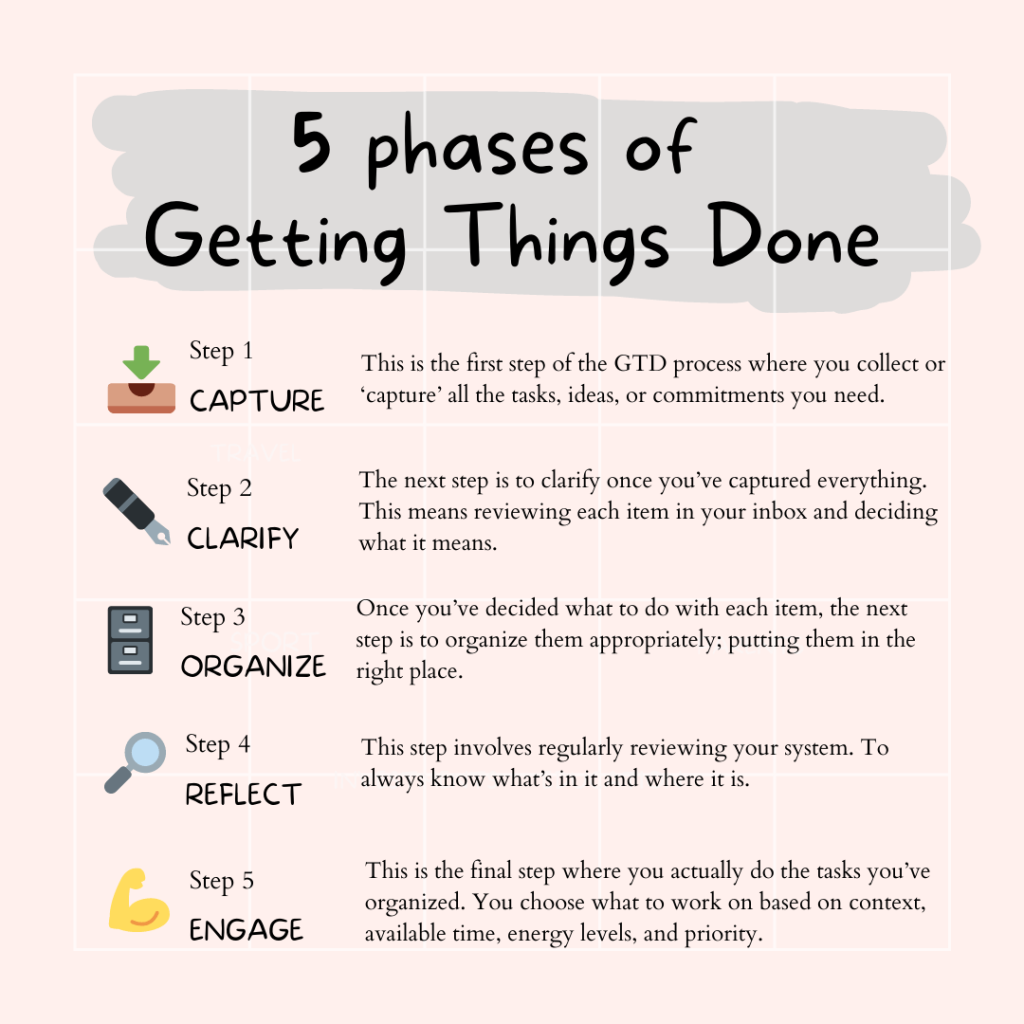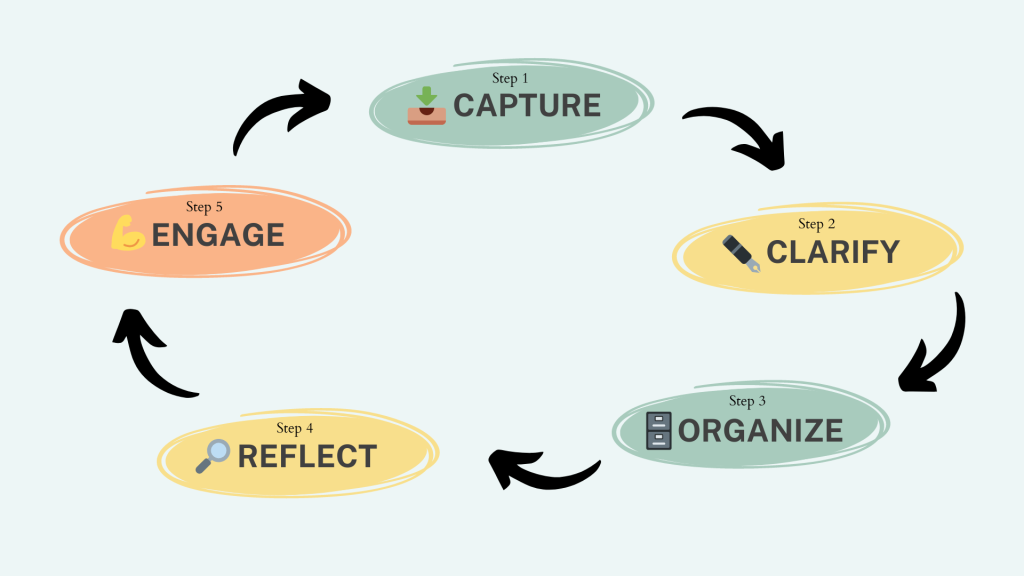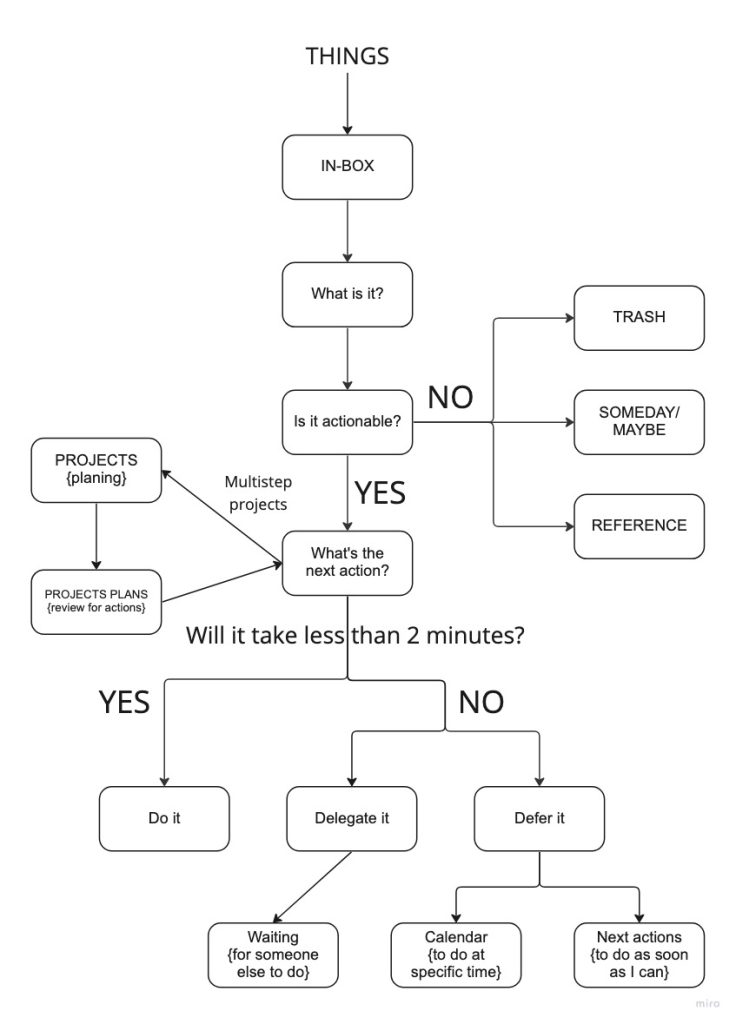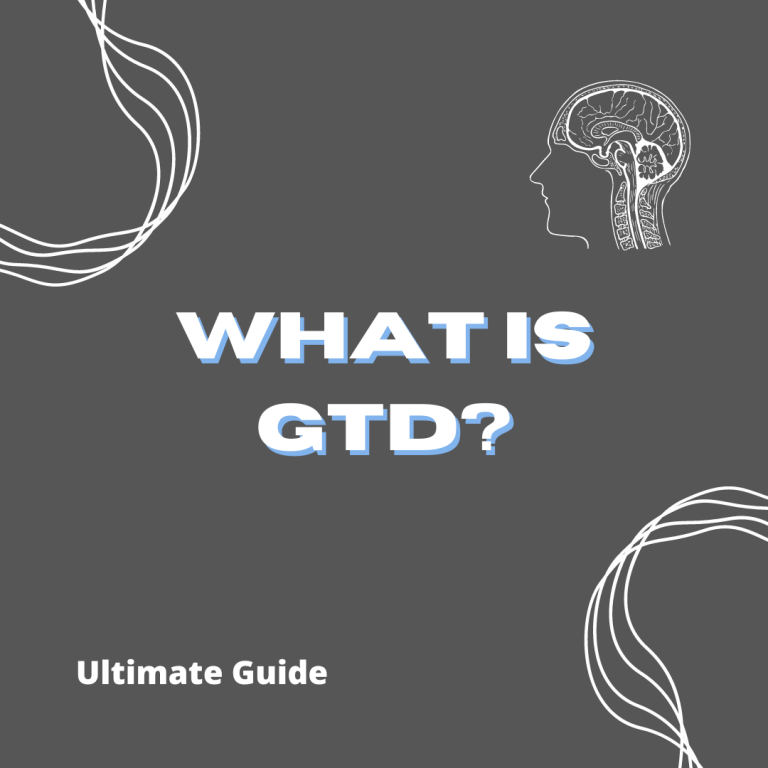Learn all about GTD. After reading this article you will know the basics of how the GTD system works. You will also be able to decide if GTD is right for you. We will answer the following questions:
- Who create GTD?
- What is GTD? Short answer
- Does the Getting Things Done method work?
- What are the 5 phases of GTD?
- What are the pros and cons of the GTD system
- How to start with GTD?
- What are the best tools for Getting Things Done?
ATTENTION, Strongly consider trying the GTD method if you:
- Feel overwhelmed by the amount of things you need to keep track of
- Experience anxiety over possibly overlooking significant details
- Juggle multiple roles and responsibilities in your professional and personal life
- Frequently initiate various projects, but face difficulties in bringing them to completion
- Have never tried the GTD approach before (it’s an experience everyone should have at least once in their lifetime)
David Allen – founder

Your mind is for having ideas, not holding them.
David Allen
David Allen is a consultant on effective work organization in large companies. He has worked as a consultant and trainer for executives around the world for more than 40 years.
After years of practice, in 2001 he published a book describing his productivity method Getting Things Done. The book had the name “Getting Things Done: The Art of Stress-Free Productivity”. And was a best-seller and has been translated into several languages. This book has changed the lives of many people.
What is GTD? Short
GTD stands for “Getting Things Done,” a time management method developed by David Allen. This method seeks to help individuals organize tasks and to-dos in a systematic way, enabling them to focus their mental energy on actually completing tasks rather than trying to remember them.
To remember, two main attributes of GTD:
- store commitments in the system not in the mind
- good organization is the key to effective execution
GTD is made up of five steps, they are designed to systematize the mess in your brain and help you get things done:

GTD is a system of rules to follow to keep your to-do list organized and easy to use all the time. David doesn’t give a single application to implement this system. You can use GTD on a piece of paper, but you can also use todo apps.
The GTD method helps you clear your mind of all the minor tasks and distractions, so you can focus on what’s important. It’s a tool for reducing stress and increasing productivity.
Does the Getting Things Done method work?
You’re probably wondering if GTD even works and if it’s worth implementing. Of course, it works! You’ll be organized like never before and you’ll feel the lightness of having all your tasks in one place.
GTD is a set of simple rules, tested by millions of people. Each person’s life is unique and it is possible that the original GTD may not be sufficient in certain areas. But this is not a problem GTD is very flexible and you can easily adapt it to your requirements keeping the main idea. And for that, I love this system.
As we wrote in the article Is GTD Still Relevant? the GTD system will never get old. Despite the fact that our world is evolving at a very fast rate, the problems we have are still similar – managing tasks efficiently, keeping track of deadlines, and maintaining a balance between professional and personal life.
GTD can be the best productivity system especially if:
- You are overwhelmed by the number of tasks
- You’re constantly worried about forgetting something
- You have many roles in life
- You often start projects but cannot finish them
5 phases of Getting Things Done
The GTD methodology comprises five distinct but interlinked phases: Capture, Clarify, Organize, Reflect, and Engage. Each phase plays a crucial role in transforming your to-do list into an actionable plan, ensuring you can navigate your day with confidence and clarity.
We’ll take a deep dive into each of these phases, exploring their importance and offering practical tips on how to implement them effectively. So, whether you’re a GTD novice or just looking for a refresher, read on to discover how the 5 Phases of Getting Things Done can revolutionize your productivity.

1. Capture: Where Every Task Finds Its Home
The journey towards effective task management starts with the first phase – Capture. This phase, quite simply, is all about gathering all the tasks that float in your mind, workspace, and life, into one central location.
Make a Big Sweep
When it comes to capturing tasks, don’t hold back. It’s time to dig deep into the crevices of your brain and sweep out all the tasks, small and big, personal and professional, immediate and long-term. This isn’t the moment to discriminate or organize. The goal is to leave no task unaccounted for.
Focus on Collecting, Not Organizing
Don’t worry about how messy your task list might seem at first. Your priority during the capture phase is to simply collect not organize. You’re just creating an inventory of tasks that need your attention. The organization will come later.
Capture Current Tasks
Focus on the tasks that you are currently dealing with. Whether it’s a project you’re working on at work, a book you’ve been meaning to read, or an email you need to respond to – it all goes into the capture list.
Collect From All Places – Email, Cards, Notebooks
No source is off-limits. Collect tasks from your email inbox, sticky notes, notebooks, voicemail, or even the notes app on your phone. Remember, you’re aiming for a comprehensive list of all your tasks, regardless of where they originated.
Material Matters – Look Around You
Sometimes, tasks are hidden in plain sight. That leaky faucet you’ve been meaning to fix, the thank-you note you need to write, or that health check-up you’ve been putting off – they’re all tasks that need capturing. These “material” tasks, often overlooked, can contribute to a cluttered mind.
Collect All the Things You Need to Do Periodically
This includes tasks that need to be done on a weekly, monthly, or yearly basis. By including them in your capture phase, you’ll ensure that they don’t slip through the cracks.
You’ll Feel Relieved
Once you’ve written down all your tasks, you’ll experience a sense of relief. You’ll no longer need to worry about forgetting anything. And if you think of anything else later, just add it to the list immediately.
2. Clarify: Defining What Your Tasks Mean
Once you’ve captured all your tasks, it’s time to enter the second phase of the GTD methodology – Clarify. This is the phase where you go through each item on your list and figure out exactly what needs to be done and how.
Types of Actions
Each item on your list will fall into one of several categories:
- If the item will take less than 2 minutes, complete it right away. This rule, known as the ‘two-minute rule’, makes it easier to tackle small tasks instead of postponing them.
- If it can be delegated, assign the task to someone else. Delegation is key to productivity. If someone else can do the task, delegate it.
- If it’s a non-actionable reference item (like a file, document, article, contact information, etc.) that you’ll need to come back to later, file it away in a separate reference project or attach it to the comments of the relevant task or project.
- If the item needs to be done at a specific date and/or time, give the task a due date. This ensures that you’re reminded of the task when it needs to be done.
- If the task is no longer needed or actionable, delete it. Not all tasks are forever. If a task is no longer relevant, discard it.
- If a task requires more than one step, create a project to house all of the items associated with it and identify the one next action you can take to move the project forward.

Tasks Should Be as Specific and Actionable as Possible
The more precise your tasks are, the easier they are to tackle. For instance, “Write a blog post about GTD” is more actionable than “Work on the blog”.
Effects of the Clarification
The process of clarification does two things. First, it makes your tasks more manageable by breaking them down into smaller, actionable items. Second, it helps you prioritize your tasks by identifying what needs to be done first, what can be delegated, and what can be discarded.
Break Items Into Multiple Tasks If Necessary
If a task seems overwhelming or time-consuming, break it down into smaller, more manageable tasks. This not only makes the task seem less daunting but also makes it easier to track your progress.
3. Organize: Structure Your Tasks for Optimal Flow
After capturing and clarifying your tasks, you now enter the third phase of the GTD methodology: Organize. Here, you’ll start to structure your tasks in a way that makes it easy to see what you need to do and when you need to do it.
Assign Categories
Categorizing your tasks is a powerful way to bring order to your list. Categories can be based on the type of task (like ‘work’, ‘personal’, ‘errands’), the time needed (like ‘quick tasks’, ‘long tasks’), or even by project. Find a system that works for you.
Understand the Context
Context is crucial when organizing your tasks. This means considering where you can do the task, the tools you need, and the amount of focus required. For example, tasks that require deep focus should be scheduled for when you’re at your most alert, while errands could be grouped together and completed in one go.
Define Your Areas of Focus
Your ‘areas of focus‘ are the key areas of your life or work where you want to dedicate your time and energy. They could include family, career, health, personal growth, etc. By identifying these areas, you can align your tasks with your long-term goals and values, ensuring that you’re spending your time in a way that truly matters to you.
Determine Your Next Action
The ‘next action’ is a fundamental concept in GTD. For every project or multi-step task, always determine the very next physical action required to move the project forward. This eliminates ambiguity and ensures you’re making progress.
Prioritize Tasks
Not all tasks are created equal. Some are more urgent or important than others. Assign a priority level to each task to ensure that your attention goes where it’s most needed. Or use the non-literal prioritization method described in this article.
Set Due Dates and Reminders
For tasks with specific deadlines, set a due date and reminders to ensure that nothing slips through the cracks. This helps keep you on track and prevents last-minute rushes.
Create a System for Regular Reviews
Regular reviews are a crucial part of the Organize phase. Schedule a specific time each week to review your task list and adjust as needed. This keeps your system relevant and ensures that nothing gets overlooked.
Make Use of Tools and Technology
There are plenty of tools available to help with task management, from simple to-do list apps to full-featured project management software. Choose a tool that fits your needs and use it to keep your tasks organized.
4. Reflect: Keep Your System Up-to-Date and Relevant
The fourth phase of the GTD methodology is Reflect. This is where you review and revise your task list and system. Regular reflection ensures that your system stays current and aligned with your changing priorities and responsibilities.
Regular Review
A weekly review is a key part of the Reflect phase. During this time, go through your task list, checking off completed tasks, updating due dates, and reevaluating priorities. This helps you stay on top of your tasks and ensures that your system is always up-to-date.
Daily Review
A daily review, although less intensive, can be beneficial. At the start or end of each day, glance through your task list. This helps keep your tasks and priorities fresh in your mind.
Keep Your System Flexible
Your task management system should be flexible. As your tasks and priorities change, so should your system. Don’t hesitate to tweak or change your categories, priorities, or even your chosen task management tool if it’s not working for you.
Reflect on Your Progress
Take some time to reflect on your progress and achievements. This isn’t just about keeping your system up-to-date, but also about recognizing your hard work and celebrating your successes. It’s a morale boost and a motivator to keep going.
5. Engage: Dive into Action with Confidence and Clarity
The final phase of the GTD methodology is Engage. With all the capturing, clarifying, organizing, and reflecting behind you, it’s now time to take action. You’ve built the structure; now it’s time to live it out.
Start with Your Priorities
Start your day or your work session by focusing on your top priority tasks. These are the tasks that align with your goals and have the biggest impact. By focusing on these first, you ensure that your most important work gets done.
Utilize Your Energy and Focus Wisely
Your energy and focus levels fluctuate throughout the day. Recognize your personal patterns and schedule your tasks accordingly. If you’re a morning person, tackle your most demanding tasks in the morning. If you’re an afternoon person, save your high-focus tasks for the afternoon.
Stay Flexible and Adaptable
Even with the best-laid plans, interruptions and changes are inevitable. Stay flexible and be willing to adapt. If a high-priority task suddenly comes up, adjust your task list accordingly.
Break Big Tasks Down
When faced with a large or complex task, break it down into smaller, more manageable tasks. This reduces overwhelm and makes it easier to start. Remember, progress, no matter how small, is still progress.
Enjoy the Process
Finally, remember to enjoy the process. Productivity isn’t just about getting things done; it’s also about enjoying the journey. Take breaks, celebrate your wins, and remember to take care of your physical and mental health.
Pros and cons of the GTD system
Like any productivity system, the Getting Things Done (GTD) methodology has its strengths and potential challenges. Let’s take a balanced look at the pros and cons of implementing the GTD system.
Pros of the GTD System
Comprehensive Task Management
The GTD system is incredibly thorough. It encompasses all tasks and responsibilities in your life, from professional obligations to personal chores and goals. This breadth ensures nothing gets overlooked.
Stress Reduction
By encouraging you to capture all tasks in an external system rather than relying on memory, GTD can significantly reduce the mental load and stress associated with juggling multiple responsibilities.
Clear Focus and Direction
The process of clarifying, organizing, and reflecting on your tasks provides a clear direction for your actions. This can increase productivity and ensure your time and energy are spent on the most valuable tasks.
Adaptability
The GTD methodology is highly adaptable. It doesn’t prescribe specific tools or systems, allowing you to tailor the methodology to suit your unique needs, habits, and preferences.
Cons of the GTD System
Initial Time Investment
Setting up the GTD system can be time-consuming. Capturing all tasks, categorizing them, and reviewing them requires an initial time investment, which might be daunting for some.
Regular Maintenance Required
To keep the system effective, regular reviews and updates are essential. If not consistently maintained, the GTD system can become outdated, cluttered, and less effective.
Risk of Over-Complexity
While the GTD system aims to simplify task management, it can become complex if not carefully managed. For example, creating too many categories or projects can lead to confusion and inefficiency.
Less Suitable for Highly Structured Environments
The flexibility of GTD can be less effective in highly structured environments where tasks and projects follow a rigid, predetermined workflow. In such cases, a more structured task management approach might be more suitable.
How to start with GTD?
The beginnings of a GTD journey can seem daunting. But there is nothing to be afraid of. It has worked for millions of people, why shouldn’t it work for you? I’ve prepared a few tips to help you with this!
Understand the Methodology
Before diving into GTD, take some time to familiarize yourself with the methodology. Read David Allen’s book “Getting Things Done“, watch online tutorials, or read blog posts (like this one!) to understand the five phases and the philosophy behind GTD.
Choose Your Tools
GTD doesn’t prescribe specific tools, which means you have the freedom to choose what works best for you. This could be a physical notebook, a simple to-do list app, or a full-featured task management tool. The key is to choose the tool that works best for you and that you will use with ease.
Start with the Capture Phase
Begin your GTD journey with the capture phase. Make a sweep of all your tasks, responsibilities, and commitments. Don’t worry about organizing or prioritizing at this stage – just focus on getting everything out of your head and into your chosen tool.
Move on to Clarify, Organize, and Reflect
Once you’ve captured everything, move on to the clarify and organize phases. Break down tasks into actionable steps, delegate if necessary, and assign due dates. Then, categorize your tasks based on your chosen system.
Set up a regular review schedule to reflect on your tasks and system. Start with a weekly review, but don’t hesitate to adjust this as needed.
Engage and Adjust
Finally, start engaging with your tasks. Begin with your top priorities and use your energy and focus wisely. Remember to stay flexible and adaptable.
Tips for Starting with GTD
- Start Small: Don’t feel like you need to capture and organize every single task right away. Start with a specific area, like work tasks or personal chores, and expand from there.
- Be Consistent: Consistency is key with GTD. Make capturing and reviewing tasks a regular habit. The more you use the system, the more natural it will become.
- Stay Flexible: Don’t be afraid to tweak and adjust the system to better suit your needs. The best productivity system is the one that works for you.
- Be Patient: Remember, GTD is a methodology, not a quick fix. It might take some time to see the benefits, but stick with it. The payoff in terms of stress reduction and increased productivity can be well worth it.
Starting with the GTD system can seem overwhelming, but with patience, consistency, and the right tools, you’ll be on your way to a more organized, productive, and stress-free life.
What are the best tools for Getting Things Done?
There are many applications that can be recommended for GTD implementation, if you want to know the full list of applications that we recommend I refer you to the article the best applications for GTD. And here I will present two applications that are my favorites.
- Todoist – todo application, but on steroids. You will find there all the necessary functions for GTD. Project breakdown, labels, filters, notifications, recurring tasks, calendar and many integrations.
- Notion – the best productivity app. You can write notes in it but just as well run a GTD system, and all in one app! And with the new Notion projects feature, it will be easier than ever.




